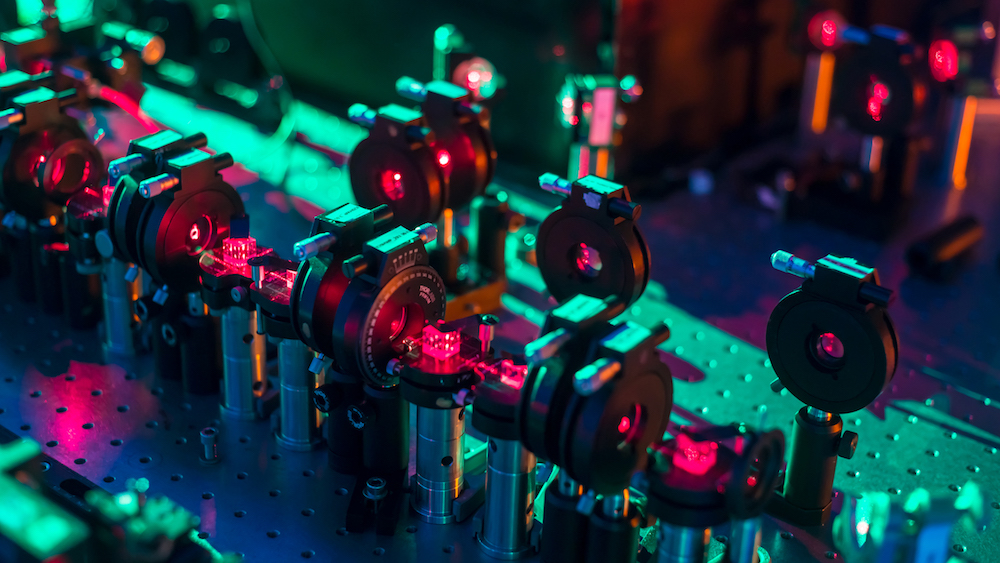This Quantum Computer Can See the Future — All 16 of Them

When Mile Gu boots up his new computer, he can see the future. At least, 16 possible versions of it — all at the same time.
Gu, an assistant professor of physics at Nanyang Technological University in Singapore, works in quantum computing. This branch of science uses the weird laws that govern the universe's smallest particles to help computers calculate more efficiently.
Unlike classical computers, which store information as bits (binary digits of either 0 or 1), quantum computers code information into quantum bits, or qubits. These subatomic particles, thanks to the weird laws of quantum mechanics, can exist in a superposition of two different states at the same time.
Just as Schrödinger's hypothetical cat was simultaneously dead and alive until someone opened the box, a qubit in a superposition can equal both 0 and 1 until it's measured. Storing multiple different outcomes into a single qubit could save a ton of memory compared to traditional computers, especially when it comes to making complicated predictions. [Twisted Physics: 7 Mind-Blowing Findings]
In a study published April 9 in the journal Nature Communications, Gu and his colleagues demonstrated this idea using a new quantum simulator that can predict the outcomes of 16 different futures (the equivalent of, say, flipping a coin four times in a row) in a quantum superposition. These possible futures were encoded in a single photon (a quantum particle of light) which moved down multiple paths simultaneously while passing through several sensors. Then, the researchers went one step further, firing two photons side-by-side and tracking how each photon's potential futures diverged under slightly different conditions.
"It's sort of like Doctor Strange in the 'Avengers: Infinity War'" movie, Gu told Live Science. Before a climactic battle in that film, the clairvoyant doctor looks forward in time to see 14 million different futures, hoping to find the one where the heroes defeat the big baddie. "He does a combined computation of all these possibilities to say, 'OK, if I changed my decision in this small way, how much will the future change?' This is the direction our simulation is moving forwards to."
Flipping a quantum coin
The researchers tested their quantum prediction engine using a classic model called the perturbed coin.
Sign up for the Live Science daily newsletter now
Get the world’s most fascinating discoveries delivered straight to your inbox.
"Imagine there's a box, and inside it is a single coin," Gu said. "At each step of the process, someone shakes the box a little bit, so the coin has a small probability of flipping."
Unlike a traditional coin toss, in which the outcome always has an equal chance of being either heads or tails, the outcome of each perturbed coin toss depends on the state the coin was in during the previous step. If the coin flipped from heads to tails during the third shake of the box, for example, then the fourth shake would be likely to remain tails.
The researchers ran two different versions of the coin experiment, one in which the box was jiggled a little more strongly and another with weaker jiggles. In each experiment, the box was jiggled four times, providing 16 possible combinations of heads and tails. Following the fourth step, the team encoded its the superposition of all 16 outcomes in a single photon, simultaneously showing the probability of every possible outcome based on the strength with which the box was shaken.
Finally, the team combined the superpositions of the strongly shaken coin and the weakly shaken coin to create one master map of possible futures.
"This showed us how quickly the futures diverged depending on how hard I shook the box at each step," Gu said.
Right now, constraints on computing power mean the team's simulator can look at only 16 possible futures at once. One day, however, as quantum computers become larger, more powerful and more commonplace, simulators like this one could be expanded to see infinitely many futures at once, Gu said. This could aid in things like weather prediction or making more-informed investments in the stock market. It could even help improve machine learning, which is all about artificial intelligence teaching itself to make better and better predictions.
This is all "highly exploratory," Gu added, and will require lots of further experimenting to figure out all the quantum simulator's applications. Alas, this clairvoyant computer's own destiny is one future that remains a mystery.
- The Biggest Unsolved Mysteries in Physics
- 18 Times Quantum Particle Blew Our Minds
- What's That? Your Physics Questions Answered
Originally published on Live Science.

Brandon is the space/physics editor at Live Science. His writing has appeared in The Washington Post, Reader's Digest, CBS.com, the Richard Dawkins Foundation website and other outlets. He holds a bachelor's degree in creative writing from the University of Arizona, with minors in journalism and media arts. He enjoys writing most about space, geoscience and the mysteries of the universe.









